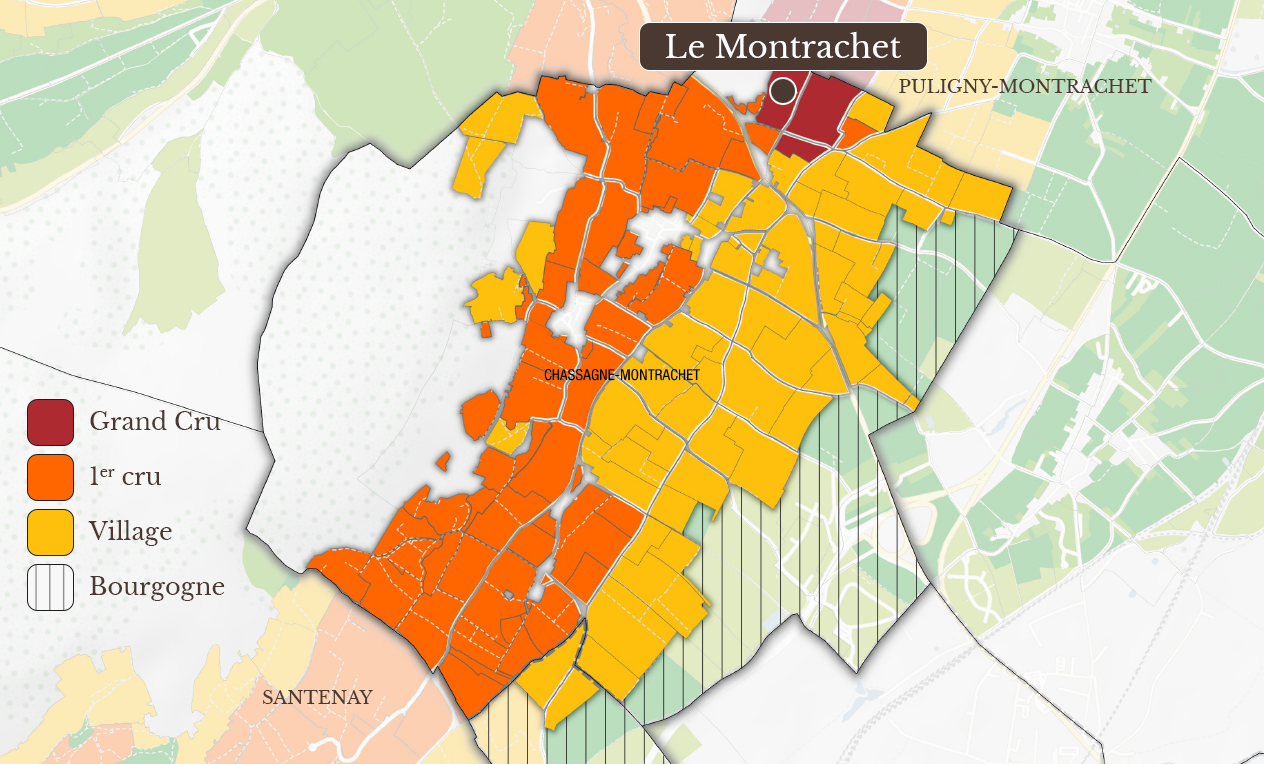«The French are so proud of their wines
that they have even named cities after their Grand Cru.»
Oscar Wilde
It is from here in Chassagne-Montrachet that “the greatest white wine in the world” flows.
Montrachet is a “climat” (also known as a plot, a cadastral locality) classified as a “Grand Cru” of less than 8 hectares shared between only 17 producers, including the Amiot family. The stony soil, the medium slope and the south-east exposure constitute a unique terroir where the Chardonnay grape variety reveals an unequalled aromatic complexity. This unique location requires excellence from the winegrowers in charge of producing the quintessence of the great white wines of Burgundy each year. The fruit of this know-how, passed down from generation to generation, is counted in bottles that are too few to satisfy the appetite of great wine lovers. At Chassagne, this rarity has a name: Montrachet.
After the creation above Chassagne and Puligny,
God rested
Montrachet is a myth in the history of wine: the vineyard, classified as an AOP “grand cru” since 1937, which allows the production of this wine, covers 7.80 ha and straddles two neighbouring communes on the Côte de Beaune in Burgundy:
- Chassagne-Montrachet : called «Le Montrachet»
- Puligny-Montrachet : called «Montrachet»
What are the great white wines of Burgundy?
The four neighbouring plots are also classified as “grand cru” and produce rare wines of great quality:
- le Bâtard-Montrachet (11,13 ha planted in Chassagne-Montrachet and Puligny-Montrachet)
- le Criots-Bâtard-Montrachet (1,57 ha planted in Chassagne-Montrachet only).
- le Chevalier-Montrachet (7,47 ha planted in Puligny-Montrachet only)
- le Bienvenues-Batard-Montrachet (3.57 ha planted in Puligny-Montrachet only)
In total, Chassagne and Puligny produce 5 of the 7 great white wines produced in Burgundy. The other two are Corton-Charlemagne and Chablis grand cru; Corton and Musigny are authorised as grand crus but they are rarely produced in white.

Source : https://bourgogne-maps.fr/
The history of Montrachet Grand Cru
From the 13th century, the vines on this site were known as “Mont Rachaz” or Mont Chauve (“Bald Mountain”), in reference to the arid and difficult to cultivate land.
In 1775, the Abbé Courtépée, a historian of Burgundy, spoke of Mont-Rachet in these terms: “It did not enjoy good repute at the beginning of the other century.”
The reputation of this wine was built up during the 18th century under the impetus of the Lords of Chagny and above all of Thomas Jefferson who, in 1787, placed it on the same level as Chambertin, which had already been renowned for several centuries.
In 1878, the two neighbours Chassagne and Puligny added the name of their famous grand cru to their commune’s name, thus becoming Chassagne-Montrachet and Puligny-Montrachet.
The Amiot family has been living in Chassagne-Montrachet since 1920 and owns two plots of Montrachet Grand Cru.
In 1921, a decision of the Beaune court defined the “Montrachet” appellation. In 1937, the AOC (Controlled Designation of Origin) was recognised by decree.
Montrachet ou Chassagne-Montrachet ?
Chassagne-Montrachet is an AOC (Controlled Designation of Origin) wine (1937), produced in the commune of Chassagne-Montrachet, in the Côte-d’Or department, in Burgundy, and also for a small portion in the neighbouring commune of Remigny, in Saône-et-Loire.
It is produced as a white wine (Chardonnay grape variety) on 200 ha and as a red wine (Pinot Noir grape variety) on 100 ha.
Chassagne-Montrachet is classified among the communal appellations of the Côte de Beaune vineyards, with 57 different Premier Crus.
In this commune, 3 plots are classified as “grand cru”: Le Montrachet, Bâtard-Montrachet and Criots-Bâtard-Montrachet.
The family of Guy Amiot produces a grand cru and 8 premier crus in white as well as 2 premier crus in red from the Chassagne-Montrachet vines.
Sources : BIVB
